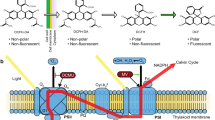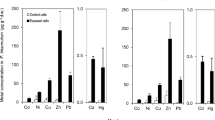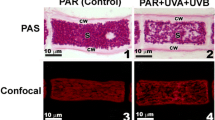Abstract
A method was developed for measurement of active oxygen production in embryonic stages of the brown seaweed Fucus spiralis, using the label CM-DCFH-DA. Active oxygen species convert the label into the green fluorescent CM-DCF (exc/em 488/530 nm) that is detected via confocal laserscan microscopy and quantitative image analysis. Loading of the label did not harm the embryos; loading efficiency was age-independent, and the esterases needed for conversion to CM-DCFH were not inhibited by the effective UV dose (2 W m−2) applied in the experiments. After correction for daily variation of the laser power, and calibration with DCF standard solutions, this automated analysis of confocal images rendered active oxygen concentrations in fucoid embryos (μM DCF). An experiment was designed for the assessment of active oxygen production following irradiance stress in the light-sensitive embryos. Dim-light-acclimated, 1-, 2- and 4-day-old embryos were transferred for 60 min to defined high-light conditions (4π-irradiance 300 μmol photons m−2 s−1), optionally without UV radiation, including UVA, or including UVA plus UVB. PSII yield measurements (PAM fluorometer) were carried out in order to assess the degree of photoinhibition under these light conditions. The imposed light stress initially caused a rapid decrease of the PSII yields (ΦP). With increasing embryo age, minimum ΦP values attained under light stress remained higher. Consequently, electron transport rates (ETR) would increase with embryo age, i.e., with the development of their photosynthetic apparatus. Active oxygen production increased with ETR, and when UVB was included, relatively greater amounts of active oxygen were produced. A slow, second-phase decrease of ΦP under light stress that was proportional to active oxygen production indicated that some photooxidative damage was caused, in particular during UVB exposure. Recovery from light stress was a rapid process in the absence of UVB; in such cases ΦP was almost restored to the initial values within 60 min. The relative state of recovery of ΦP was correlated with both the effective UV dose and active oxygen production rate (DCF). Recovery was slowest in embryos exposed for 60 min to an experimental UVB dose, which was representative of a situation at low tide, on a sunny day. The results suggest that active oxygen may cause an in situ inhibition of growth of the earliest life stages of F. spiralis.
Similar content being viewed by others
Author information
Authors and Affiliations
Additional information
Received: 26 January 2000 / Accepted: 4 September 2000
Rights and permissions
About this article
Cite this article
Rijstenbil, J., Coelho, S. & Eijsackers, M. A method for the assessment of light-induced oxidative stress in embryos of fucoid algae via confocal laserscan microscopy. Marine Biology 137, 763–774 (2000). https://doi.org/10.1007/s002270000443
Issue Date:
DOI: https://doi.org/10.1007/s002270000443




